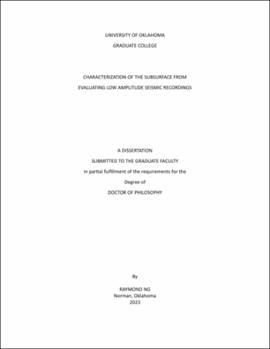| dc.description.abstract | A geoscientist yearns to learn more about the subsurface and one way of characterizing the subsurface is through active seismic methods which utilize a local source to initiate a strong waveform (e.g., explosives, vibroseis, sledgehammer). However, active sources are generally costly to operate, and logistically complicated since, depending on location, they require approval from an authorizing body, and are very intrusive and disturbing to the environment. Alternatively, passive seismic methods are preferred due to their low cost, ease of instrument deployment, and low environmental impact. Passive seismic is not without its caveats. Passive seismic relies on the surrounding ambient seismic noise for measurements, which can be influenced by local noise sources (e.g., vehicles, strong wind), effectively lowering the signal-to-noise ratio. I will present an array of exciting results from low-amplitude seismic recordings and novel approaches to measuring them to understand the seismic noise environment and microseismic events, which have implications for the field of seismology. I will show an improved analysis of seismogenic potential from magnitude calibration, an interpreted resonant subsurface boundary determined from resonance frequencies, and a correlation of wind speed and seismic recordings. I use an induced seismicity catalog recorded by two nearby boreholes to apply a novel workflow of waveform correlation to 2074 earthquakes for magnitude calibration and subsequent evaluation of seismogenic potential. Waveform correlation reveals statistically significant differences in b-value and seismogenic potential after calibration and suggests a dependence of the earthquake statistics upon their optimal or suboptimal orientation to the local stress field. In another study, we utilize distributed acoustic sensing (DAS) recording, which allows for a high density of receivers with minimal field deployment. The technique leverages novel sensors to measure backscatter from a telecommunication dark fiber, resulting in a time series of strain along the cable, effectively 100s to 1000s of “seismometers.” Comparison between this novel sensing device and traditional sensors reveals the higher noise level of DAS. However, the higher spatial resolution of DAS allows for stacking measurements along channels and identifying noise sources that were previously not easily recognizable in traditional arrays. Recorded measurements are often subject to increased background noise in an urban or noisy environment. From seismic recordings across Oklahoma from dense arrays, I examine the effects of wind and wind turbines on recorded seismic noise via single-station site response techniques to determine site resonance frequencies and noise source origin. | en_US |
